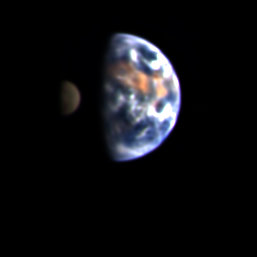How do you get the most out of one spacecraft and find exoplanets in the process? Re-use, recycle and share. The spacecraft bus that brought the Deep Impact “impactor” to comet Tempel 1 in July of 2005 is still out in its heliocentric orbit and has been put to work double time where two new missions are sharing the same spacecraft. The combined operation is called EPOXI, which is a combo-acronym of the two separate missions. The Deep Impact Extended Investigation (DIXI) of comets will observe comet 103P/Hartley 2 during a close flyby in October 2010. But of current interest is the other half of the dynamic duo, called the Extrasolar Planet Observation and Characterization (EPOCh) which is observing stars already known to have transiting giant planets. Since the orbital plane of the giant planet has been identified, EPOCh is looking in that same plane for planets closer to Earth size. So far, 4 new planets have been found with this spacecraft, using the transit method. But EPOCh is also looking back at our home planet, using Earth as a baseline to be able to identify features on an exoplanet, such as continents and oceans.
The EPOXI team has focused most of its attention on the star GJ436. This red dwarf star which is 32 light-years from Earth has a Neptune-sized planet that transits in front of the star. Spitzer observations have shown its orbit to be oval shaped, or eccentric. “That virtually guarantees there is a second planet in this system,” said Drake Deming, Deputy Principal Investigator for EPOXI . “We have three weeks of data on this system. The habitable zone corresponds with where we believe this planet to be, and we hope to be below the Earth as far as the size.”
Earth observations will help to calibrate future observations of Earth-like exoplanets. EPOXI obtained a particularly interesting view of the Earth on May 29, when the Moon passed in front of the Earth as viewed from the spacecraft. This “transit” of the Moon is an event that may also be observed to occur for Earth-like exoplanets, and it may help us to deduce the nature of their surface features.
Deming and Deep Impact team leader Michael A’Hearn both said that sharing the spacecraft has gone smoothly. The EPOCh mission will continue until August 30 of this year, with the option of doing more planet searching if the team is able to preserve the margin of hydrazine fuel on board. “But,” said Deming, “when the hydrazine runs out we’re done for sure.”
Source: AAS press conference


I have to say that the ‘little’ news like this make me almost as happy as the big ones on Mars.
It’s very gratifying to learn just how ingenious scientists can be when it comes to not wasting money.
“It’s very gratifying to learn just how ingenious scientists can be when it comes to not wasting money.”
Yeah – Deep Impact has been great value!
Keeping these machines in operation in such a hostile universe for the original mission is amazing in itself. Especially if the spacecraft spends any time away from Earth’s protection.
Keeping them alive in order to find new things for them to do is absolutely astonishing. Especially when it comes to finding extrasolar planets. Which for me, is the next best thing to controlling the electron!
Makes comple sense. Now to design them all like gobots so if they do crash into something all the parts can be programmed to reassemble into anything ground control dictates. Some spacecraft of the future might subdivide into smaller ones or connect with other craft into large ones.